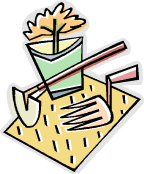Panhandle Plantings-A new column by Master Gardener Val Ford

Florida is synonymous with sun and warm weather. Yet, one of the most perplexing gardening problems is that of shade -- No, not how to achieve it, how to deal with it once you have it.
The University of Florida pamphlet, "North Florida Landscape Plants for Shaded Sites," categorizes light at three levels:
(1) Full sun – 11 a. m. to 2 p. m.;
(2) Partial shade – direct sun from7 to 11 a. m.; and
(3) Full shade – no direct sunlight. But then the pamphlet states that shade is not simply a matter of "duration of light," but also the "intensity" of shade! That clears things up dramatically, don’t you think?
Never fear, the pamphlet does provide a good listing of landscape plants for shade and partial shade sites – and does give us a jumping off point to break down the topic a bit more specifically.
One of the first things to consider is that shade "patterns" and their "intensity" will change with the time of day and the time of year. That tree or building or wall may remain stationary, but the sun and the earth don’t. Taking the time to "map" your shade patterns over the course of a year is a worthwhile long-term investment.
Shade areas created by buildings or walls are not as difficult to work with as those under or around trees. A few basics go a long way . . .
(1) If you must landscape under or around a tree, do so when the tree is young so that the partnership will mature together. Also, take into consideration the nature of the tree and partner plants that will be compatible in the long term. If you should choose plants that require more sunlight than the mature tree will provide, consider what "limbing up" (removing lower limbs to provide more sunlight) will do to the tree’s form and presence in the landscape.
(2) If you have mature tree shade, consider that this is not an area well suited to short-term, ever-changing plantings, i.e. annual "color." Repeated disturbance of the soil stresses the tree roots and the effect will always look somewhat unsettled and artificial because it will never have time to establish.
If there is nothing growing underneath that tree when you take a shine to plant there, it’s usually a pretty good giveaway that you will be dealing with soil that is dry and infertile with an abundance of shallow and enmeshed tree roots. In this situation, the tree has a definite head start on your plantings. Choose tough, adaptable, undemanding perennials, but be aware that even they will require extra water and fertilization for at least two to three growing seasons to ensure survival. If you are still bound and determined to have color, utilize container plantings.
(3) Colors are intensified in shade. Light colors (bright greens, light pinks and white) will "shimmer" and appear closer than they really are. Dark colors (mostly greens) will give the impression of receding. White will create the illusion of a light source, and also serves to harmonize masses of conflicting color.
Shade does not preclude a vegetable garden. Vegetables that "fruit," i.e. tomatoes, melons, squash and peppers, require a minimum of 8-10 hours of sunlight to produce, but are quite appreciative of afternoon shade. Root crops or leafy vegetables will produce in 6-8 hours of light per day. Many herbs, including sorrel, chives, mint, parsley and lemon balm are quite happy with as little as four hours of light daily. The same can be said for peas, beans, spinach, artichokes and cucumbers.
What about turfgrass, you say? The University of Florida recommends two species as suited for shady sites – St. Augustine and Zoysiagrass. Yet even these grasses require some special maintenance, such as increasing mowing height to reduce stress and increase the leaf area available for photosynthesis, reducing fertilizer applications and irrigation rates and reducing traffic flow in these areas.
Finally, that horticultural aspect for which shade is most virtually all-important – the gardener. Need I say more?
Val Ford is a Holmes County Master Gardener. She is a three-time recipient of the Florida MG Award for Written Mass Communications for the weekly DeFuniak Springs Herald "Gardeners’ Dirt" column. If you have gardening questions or problems, contact your local County Extension Office, or Val at Flsnowflake7592@aol.com.
Page created and maintained by West Florida Electric Cooperative, Inc. © 2001.
designed by embryo design